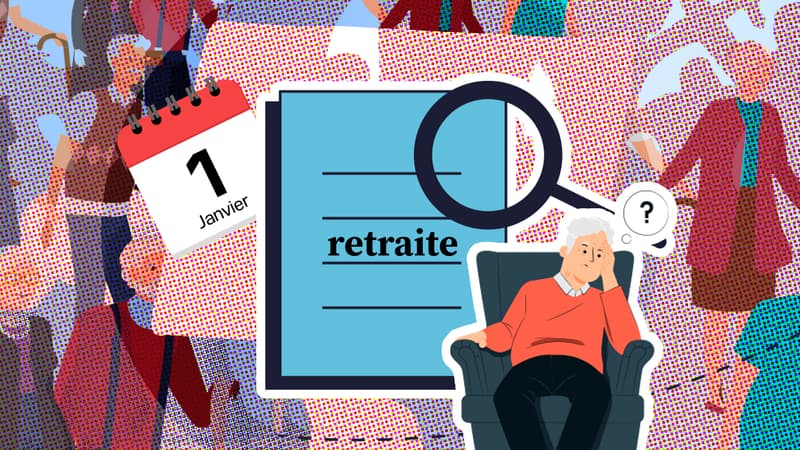Despite a pay-as-you-go system, all of our pension plans have accumulated reserves that reached 206 billion euros at the end of 2021.
If the total sum is significant, it must be put into perspective when compared with the 345,000 million euros that weighed gross retirement spending (before social security contributions) in 2021. This 345,000 million takes into account both pensions basic payments paid as top-up or other payments (such as survivor’s pension).
In addition, behind its 206,000 million there are strong disparities between plans: some have been much more cautious than others.
The complementary private fund owns 40% of global reserves
Agirc-Arrco, the supplementary pension fund for private sector employees, is at the forefront of the schemes that have accumulated the most funds over the years. It has 86.5 billion in reserve, or about 40% of the total sum accumulated at the end of 2021, and has no debt. During this same period, more than 13 million retirees took advantage of the compulsory complementary insurance that complements the basic regime.
These funds are needed to address “economic and demographic” dangers, according to Agirc-Arrco.
More generally, the funds of the complementary regimes concentrate the vast majority of the total financial reserves: 161 billion of the 206, according to the COR.
Thus, the complementary CNAVPL (National Fund for Old Age Insurance of the Liberal Professions), which is also added to the basic pensions but for the liberal professions, does not lack resources either, with more than 33,000 million euros accumulated. The sum is certainly less impressive than Agirc-Arcco but, by guaranteeing a much smaller number of retirees, its funds at the end of 2021 would be enough to finance its services for the next 9 years. Meanwhile, Agirc-Arrco’s reserves would allow it to pay its many retirees for little more than a year.
In third position in terms of the size of its assets is a little-known organization with somewhat special functions: the Pension Reserve Fund. The FRR, created in 1999 to cushion the blow of the grandpa-boom, weighed 26,000 million euros at the end of a 2021 that was good thanks to the rise in stock prices. Like a pension fund, it invests public money in the financial markets and then returns it to the pension system.
Since 2011, it distributes 2,100 million euros each year to CADES (Social Debt Amortization Fund). The latter is intended to help settle social debt, that is, debt linked to past deficits of the various branches of social security, including retirement. The FRR’s mission is, therefore, to pay part of the liabilities of pension plans that are short of money.
diets that are dry
Many acronyms to say that there are plans that regularly do not have enough money to finance their retirees.
The Caja Nacional del Seguro de Vejez, or CNAV, is the basic scheme that manages the pensions of private sector employees. At the end of 2021, it secured the retirement of almost 15 million French people and posted a deficit of more than one billion euros.
This fund has no reserves in its coffers. And she’s not the only one suffering from a lack of cash flow.
The Solidarity Fund for Old Age (FSV), the body that supports the financing of minimum old age, cannot balance its accounts either. Its deficit weighed, for example, 1,500 million euros in 2021.
The reserves of the Mandatory Basic Regime and the FSV, like their peers, suffered from the Covid pandemic in 2020 and the drop in contribution flows, before benefiting from the economic upturn in 2021. But their deficit is bound to deteriorate rapidly due to a demographic situation that will be increasingly unfavorable for them. Indeed, there will be fewer and fewer active people, and therefore contributors, compared to the number of retirees.
Accounts payable and working capital
Likewise, it is necessary to look at the reserves mentioned by the COR without forgetting the debts that remain to be repaid for all plans. Accumulated over the years, the past debts of the social security retirement branch already weigh heavily. “In total, the quota attributable to the retirement branch of the debt pending repayment of Cades is estimated at 43,000 million euros,” explains the COR in its report. If these 43,000 million are discounted, the global “net” financial reserves of the pension systems no longer represent 206,000 million euros but only 163,000 million euros. However, it is a theoretical calculation because Agirc-Arrco’s reserves, for example, are not intended to finance the debts of the basic general regime or those of the special regimes.
Another important element to take into account: the amounts indicated in the COR report include medium and long-term reserves and working capital. These correspond to the cash that a pension organization can immediately dispose of to finance its current activities.
If we put this working capital aside, Agirc-Arrco, for example, no longer has 86.5 billion euros in reserves, but only 68 billion euros. The joint body has also specified to BFM Business that its reserves, excluding working capital, should still be below $70 billion by the end of 2022.
Source: BFM TV


